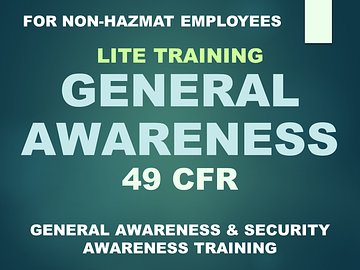Hazardous Materials / Dangerous Goods Transportation - General Awareness and Security Awareness by All Modes (49 CFR, Canadian TDGR, ADR 2025, Mexican NOMs, IMDG Code Amd. 42-24, and ICAO / IATA Edition 66) - 2025
Finish in
71 mins!
Employees
only
of Completion
Friendly
Access
What you'll learn
Skills covered in this course
Description
Learning Objectives / Modules:
- General Awareness. Provide employees with the hazardous material transport requirements of 49 CFR, TDGR, ADR, NOMs, IMDG Code, and IATA DGR, including:
- Recognizing & identifying hazardous materials
- Protective packaging
- Hazard communication: marking, labels, placards
- Documentation
- Loading & segregation
- Freight securement
- Handling / accident prevention
- Emergency response
- Security Awareness. Provide employees with an awareness of the security risks associated with the transportation of hazardous materials requirements and their role in enhancing hazardous materials transportation security.
Target Audience:
Hazmat/DG employees with job responsibilities for shipping, logistics, management, and freight forwarders who prepare, handle, ship, or transport hazardous materials domestically and internationally. This may include, but is not limited to, the following:
- warehouse staff that are packaging hazmat/DG
- office staff that are preparing shipments of hazmat/DG
- employees responsible for ordering hazmat/DG goods shipping supplies (i.e. marks, labels, packaging, etc.)
- pick/packers
- logistics staff marking, labeling packages
- logistics staff loading/unloading hazmat/DG
- employees preparing, or validating/signing, hazmat/DG documentation
- staff providing or offering placards or placarded loads
- supervisors with hazmat/DG transportation compliance responsibilities
- customer service staff or procurement staff that are addressing customer’s hazmat/DG goods returns
Pre-requisite: None required
Required & Recommended Regulatory Resources:
Click this link for a list of the recommended regulatory resources for this course: Required & Recommended Resources
Course Features:
- Estimated Time: 1h30m run-time, plus assessment time which varies per person
- Language: English
- Includes final assessment to validate student’s understanding of material
- Training certificate (including a wallet card) will be issued upon successful completion of the course.
- Note: Upon issuance, the training certificate must be signed by both the employee and the employer.
- Note: Currie Associates training certificates do not meet the requirements for a CNS endorsement application and will not reflect IATA accreditation.
- Per the regulations, it is the responsibility of the employer to provide training to their employees. Per ICAO/IATA's Competency Based Training approach, the employer is responsible to assess their employees’ ability to successfully perform their job functions covered in this training.
Table of Contents
Recognizing & identifying hazardous materials
Protective packaging
Hazard communication: marking, labels, placards
Documentation
Loading & segregation
Freight securement
Handling / accident prevention
Emergency response
Author
Currie Associates Online Training Website - DG Compliance Online
Currie Associates, Inc. and the International Vessel Operators Dangerous Goods Association (IVODGA) offer online Dangerous Goods/Hazmat and safety training for you and your employees 24 hours a day, 7 days a week. Our automated safety and compliance training tool is designed to help you efficiently and effectively train individual employees and track their progress in far less time than more traditional training methods.
Hazardous Materials / Dangerous Goods Transportation - General Awareness and Security Awareness by All Modes (49 CFR, Canadian TDGR, ADR 2025, Mexican NOMs, IMDG Code Amd. 42-24, and ICAO / IATA Edition 66) - 2025







Learning Objectives / Modules:
Hazmat/DG employees with job responsibilities for shipping, logistics, management, and freight forwarders who prepare, handle, ship, or transport hazardous materials domestically and internationally. This may include, but is not limited to, the following:
Required & Recommended Regulatory Resources:
Click this link for a list of the recommended regulatory resources for this course: Required & Recommended Resources
Course Features: